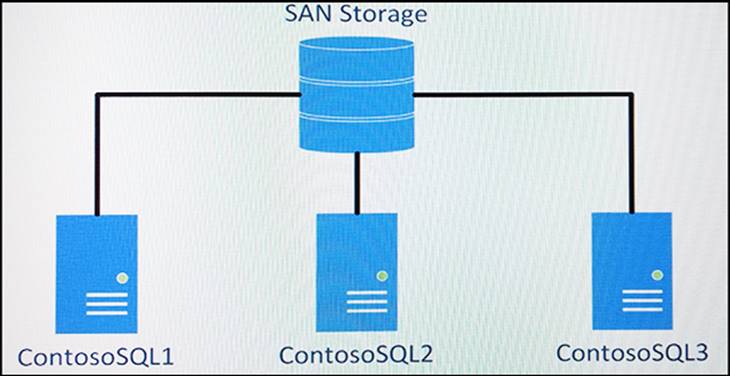- All Exams Instant Download
You are planning the deployment of two new Always On Failover Cluster Instances (FCIs) of Microsoft SQL Server to a single Windows Server Cluster with three nodes
HOTSPOT
You are planning the deployment of two new Always On Failover Cluster Instances (FCIs) of Microsoft SQL Server to a single Windows Server Cluster with three nodes.
The planned configuration for the cluster is shown in the Server Layout exhibit. (Click the Exhibit button.)

The SAN team has configured storage for the cluster and sent the configuration to you in the email shown in the SAN Team Email exhibit. (Click the Exhibit button.)

Each node of the cluster has identical local storage available as shown in the Local Storage exhibit. (Click the Exhibit button.)

All local storage is on SSD. You need to plan specific configurations for the new cluster. For each of the following statement, select Yes if the statement is true. Otherwise, select No.

Answer: 
Explanation:
Box 1: Yes
tempdb on local storage. FCIs now support placement of tempdb on local non-shared storage, such as a local solid-state-drive, potentially offloading a significant amount of I/O from a shared SAN.
Prior to SQL Server 2012, FCIs required tempdb to be located on a symmetrical shared storage volume that failed over with other system databases.
Box 2: No
The VNN is set on the group level, not on the instance level.
Database client applications can connect directly to a SQL Server instance network name, or they may connect to a virtual network name (VNN) that is bound to an availability group listener. The VNN abstracts the WSFC cluster and availability group topology, logically redirecting connection requests to the appropriate SQL Server instance and database replica.
The logical topology of a representative AlwaysOn solution is illustrated in this diagram:

Box 3: No
You don’t configure the SAN from a SQL Server, instead you can use a Microsoft Server server.
References: http://download.microsoft.com/download/d/2/0/d20e1c5f-72ea-4505-9f26-fef9550efd44/microsoft%20sql%20server%20alwayson%20solutions%20guide%20for%20high%20availability%20and%20disaster%20recovery.docx
Latest 70-764 Dumps Valid Version with 451 Q&As
Latest And Valid Q&A | Instant Download | Once Fail, Full Refund
Subscribe
Login
0 Comments
Inline Feedbacks
View all comments

